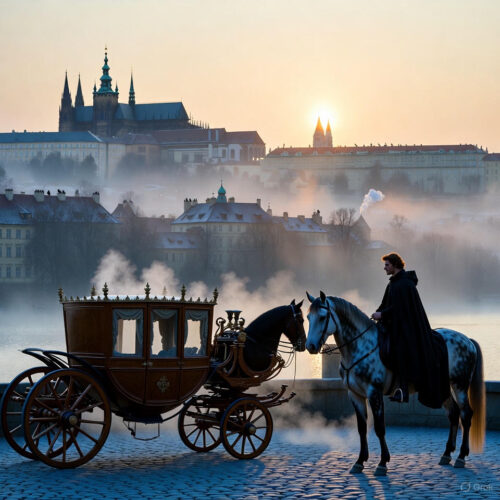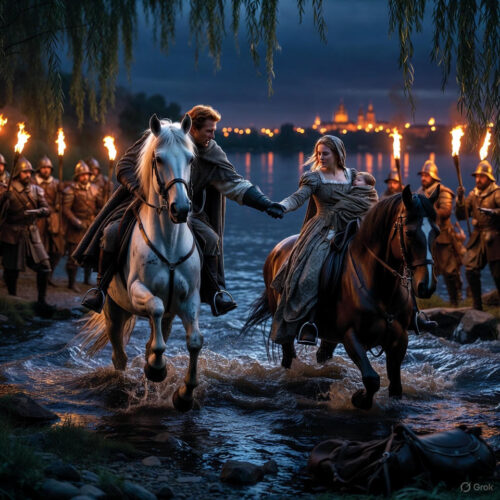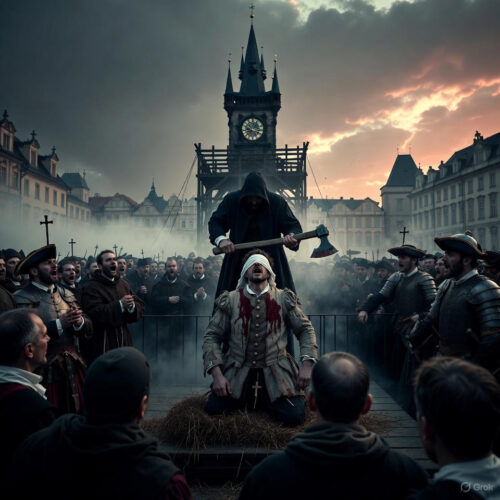Imagine a crisp autumn morning in 1620, the kind where the air bites with the promise of winter, and the hills around Prague shimmer under a thin frost. The city, a jewel of spires and stone in the heart of Bohemia, hums with the tension of a realm on the brink. For months, whispers of rebellion have swirled like leaves in the Vltava River—Protestants railing against the iron grip of Catholic Habsburgs, nobles plotting in shadowed taverns, and a young king, crowned in haste, dreaming of a new order. But on this day, November 9, dreams shatter like fragile glass. Frederick V, the Elector Palatine turned “Winter King,” bolts from his palace, his wife Elizabeth clutching their infant children, as imperial cannons echo from the distant White Mountain. This is no mere skirmish; it’s the fulcrum of the Thirty Years’ War, a cataclysm that would devour Europe in flames for decades. Yet from this flight—raw, desperate, human—emerges a lesson etched in history: even in utter defeat, the human spirit forges paths of adaptation and quiet rebellion. Today, four centuries later, that same spark can ignite your own life, turning setbacks into stepping stones. Buckle up; we’re diving deep into the chaos, the characters, and the cunning survival that followed, before extracting the gold for your modern grind.
To grasp the magnitude of Frederick’s flight, we must wind back the clock to the powder keg of early 17th-century Europe. The continent was a patchwork of feuding faiths, ambitious empires, and fragile alliances, all simmering under the vast canopy of the Holy Roman Empire. At its core lay Bohemia, a crownland of rolling hills, dense forests, and a populace split like a fault line between Catholic loyalists and Protestant reformers. The year 1609 had seen Emperor Rudolf II, in a moment of weakness amid his own succession woes, issue the Letter of Majesty—a grand charter granting Bohemian Protestants broad religious freedoms, including the right to build churches on royal lands and worship without interference. It was a fragile peace, inked on parchment but tested by every sermon and edict.
Fast forward to 1617, and the winds shift. Rudolf’s successor, Matthias, clings to the throne but eyes his cousin Ferdinand of Styria as heir. Ferdinand, a firebrand Jesuit-educated Catholic, arrives in Prague like a storm cloud. Tall, stern, with a jaw set like carved granite, he embodies the Counter-Reformation’s zeal: reclaim Protestant-seized church lands, stamp out heresy, and centralize power under Vienna’s Habsburg scepter. By 1618, Bohemian nobles—merchants, landowners, and clergy hardened by decades of Reformation fervor—see the writing on the wall. On May 23, in the grand Spanish Hall of Prague Castle, a assembly of Protestant lords confronts two imperial governors, Jaroslav Borzita of Martinice and Wilhelm Slavata, alongside secretary Philip Fabricius. Words fly like arrows; then, in a theatrical flourish that history would immortalize, the nobles seize the trio, hurl them from a 70-foot window, and watch as they tumble toward the manure-strewn moat below. Miraculously—or divinely, depending on your theology—the officials survive the Third Defenestration of Prague, cushioned by a fortuitous pile of waste. It’s the spark: Bohemia erupts in revolt, forming the Protestant Union and expelling Catholic officials.
Enter Frederick V, our tragic protagonist. Born in 1596 in Amberg, the eldest son of Frederick IV, Elector Palatine, young Frederick grows up in the Rhine Valley’s Protestant heartland. Educated at Heidelberg University, he’s a product of the era’s intellectual ferment—Calvinist rigor mixed with Renaissance humanism. Charming, idealistic, with a mane of auburn hair and eyes that burn with conviction, he’s dubbed the “Romantic Elector” for his patronage of arts and tolerance. By 1613, married to Elizabeth Stuart—daughter of England’s James I, a vivacious beauty known as the “Queen of Hearts”—Frederick rules the Palatinate, a wealthy electorate chafing under Habsburg dominance. When Bohemian envoys arrive in 1619, begging for a Protestant king to defy Ferdinand, Frederick hesitates. Elizabeth urges him on, whispering of glory; his advisors warn of ruin. In a midnight council at Heidelberg Castle, he accepts. On November 4, 1619, Protestant electors crown him in Prague’s St. Vitus Cathedral, a coronation rushed under gray skies, with cheers echoing off the Charles Bridge. Frederick V becomes King of Bohemia, but his reign will last just one winter—hence the moniker.
The revolt, now the Bohemian phase of what will balloon into the Thirty Years’ War, draws in mercenaries and misfits from across Europe. Frederick’s forces swell to 30,000: grizzled Landsknecht pikemen from Germany, Hungarian hussars with curved sabers glinting in the sun, even Scottish adventurers lured by pay and piety. Command falls to Christian of Anhalt-Bernburg, a 60-year-old warhorse with a scarred face and a reputation for bold (if reckless) maneuvers. Anhalt, Frederick’s father-in-law by a previous marriage, had fought in the Long Turkish War, where he learned the brutal arithmetic of gunpowder and steel. Opposing them: Ferdinand II, now Holy Roman Emperor, allies with the Catholic League led by Bavaria’s Maximilian I and Spain’s tercios—elite infantry drilled to perfection. Field Marshal Johann Tserclaes, Count of Tilly, a diminutive Walloon with a philosopher’s mind and a butcher’s resolve, commands 22,000 battle-hardened troops. Tilly, born in 1559, is the son of a Brussels baker; his rise through Jesuit schools and imperial service makes him a symbol of disciplined faith. Beside him rides Charles Bonaventure de Longueval, Count of Bucquoy, a French-born Habsburg general whose Spanish phalanxes have crushed Dutch rebels.
Summer 1620 sees a whirlwind of marches. Imperial forces, fresh from subduing Moravia, slice through western Bohemia like a scythe. Frederick, ensconced in Prague’s opulent Hradschin Palace, pens frantic letters to Protestant princes for aid—Denmark’s Christian IV dithers, England’s James I offers platitudes. Anhalt, ever the gambler, force-marches his army 200 miles in two weeks to intercept Tilly at the Karlštejn fortress, but arrives too late. By late October, the Bohemians dig in on White Mountain (Bílá Hora), a low ridge five miles west of Prague, its slopes dotted with vineyards and ancient oaks. The position is defensible—flanked by ravines, with artillery perched on the crest—but rain-soaked ground and low morale sap their strength. Desertions whittle their numbers to 15,000-21,000; supplies dwindle, and camp fevers claim hundreds.
November 8 dawns foggy, the air thick with the scent of wet earth and unwashed men. Tilly’s scouts probe the lines at dawn, a feint by 300 cuirassiers that panics the Bohemian left flank under Matthias von Thurn, a hot-headed noble whose family estates lie in the path of imperial wrath. Thurn’s men—mostly raw Moravian levies—break and flee toward the city, their pikes clattering like fallen dominoes. Anhalt rallies, dispatching his son, young Christian II, with 2,000 cavalry in a thunderous charge. Sabers clash, pistols crack; for a fleeting hour, the Protestants push back, Tilly’s reiters staggering under the onslaught. But the old marshal, cool as a crypt, wheels his reserves: Bavarian hussars under Count Fugger slam into the Bohemian rear, while Bucquoy’s tercios advance in unyielding squares, matchlocks belching smoke. A single volley from the imperial artillery—12 bronze culverins hurling 24-pound balls—shatters the Protestant center. Within 60 minutes, it’s over. Four thousand Bohemians lie dead or dying, their blood seeping into the chalky soil; Tilly loses fewer than 800. Among the routed is a young French philosopher, René Descartes, embedded with the Catholic League as an observer—his firsthand account would later muse on the “wonderful order” of Tilly’s formations, even as chaos reigned.
As dusk falls on the 8th, Prague’s bells toll in dread. Frederick, 24 and unbloodied by battle, receives the news in his chambers: couriers gasp of shattered lines, Anhalt in flight. Elizabeth, eight months pregnant with their sixth child, packs jewels into saddlebags, her ladies-in-waiting stifling sobs. The king, pale but resolute, kisses his three-year-old son, the future Rupert of the Rhine, and whispers prayers. At midnight, under cover of darkness, the royal party slips out the Lesser Town gate—Frederick on a dappled stallion, Elizabeth in a hooded cloak astride a gentle mare, trailed by 200 loyal guards and wagons groaning with plate and portraits. They ford the Vltava at a shallow bend, the water icy to their knees, then gallop northeast into the Bohemian forests. By dawn on November 9, 1620, they reach the Silesian border at Hradec Králové (Königgrätz), hearts pounding from the hoofbeats of pursuing scouts. It’s a 50-mile dash through mud-churned roads, evading patrols, with Frederick shedding his crown jewels piece by piece to lighten the load. In Wroclaw (Breslau), Polish soil offers sanctuary, but it’s exile: Frederick, the king who dreamed of a Protestant empire, reduced to a penniless prince in a borrowed castle.

The imperial vanguard—2,000 Bavarian horse under Colonel von Mercy—thunders into Prague by noon on the 9th, their trumpets blaring Te Deums. Old Town Square becomes a carnival of retribution: Catholic friars process with relics, while looters smash Protestant icons. Ferdinand II, arriving days later in a gilded coach flanked by 10,000 troops, decrees martial law. The purge is swift and savage. On November 21, a tribunal of Habsburg judges convenes in the Carmelite monastery; 200 noble prisoners, chained in the dungeons below, face charges of treason and heresy. Interrogations drag through December—torture chambers echo with screams, thumbscrews twisting confessions from lords like Vilém Vok z Rožmberka, whose family traced to the 12th century. Twenty-seven are condemned: heads roll on scaffolds erected in the square, their bodies quartered and gibbeted as warnings. Among them: anatomist Jan Jesenius, whose tongue is nailed to the block before decapitation (a jab at his anti-Catholic writings), and polymath Kryštof Harant z Polžic, traveler and composer whose Asian adventures filled tomes now consigned to flames. The executions, public spectacles attended by 20,000, leave blood pooling in the cobblestones; today, 27 baroque crosses mark the spots, a somber mosaic under the Astronomical Clock.
The aftermath ripples like a stone in a pond. Bohemia, once a Protestant bastion with 80% of its nobility Utraquist or Hussite, undergoes forced recatholicization. Ferdinand’s 1621 Edict of Restitution demands return of all church lands seized since 1552—thousands of parishes, schools, and breweries revert to Jesuits. Non-Lutheran Protestants (Calvinists like Frederick’s followers) get three months to convert or flee; Lutherans, a year. By 1624, 150,000 Bohemians emigrate: artisans to Saxony, nobles to the Netherlands, peasants to Poland. The population plummets— from 3 million in 1618 to 800,000 by 1650, ravaged by war, plague, and famine. Prague’s university, once a hive of Hussite scholarship, becomes a Jesuit stronghold; its libraries burned, professors exiled. Economically, it’s devastation: silver mines at Kutná Hora idle, trade routes to Nuremberg choked, vineyards trampled. Culturally, Czech language wanes as German administrators impose their tongue; the aristocracy germanizes, intermarrying with Viennese elites.
Yet Frederick’s flight isn’t mere tragedy—it’s a pivot. In exile, he becomes a nexus for Protestant resistance. From The Hague, where he settles in 1623 with Elizabeth (their “fairy-tale court” a whirlwind of poets like Ben Jonson and painters like Van Dyck), he rallies the Dutch Republic and Danish crown. His son Rupert, born amid the flight’s chaos, grows into a Royalist general in England’s Civil War, his cavalry charges echoing White Mountain’s fury. The battle’s shadow lengthens the war: Denmark intervenes in 1625, crushed at Lutter; Sweden’s Gustavus Adolphus in 1630, turning tides at Breitenfeld. By Westphalia in 1648, 8 million dead, the Peace of Münster carves Europe anew—religious tolerance enshrined, Habsburg absolutism checked. Bohemia’s “Dark Age” lasts two centuries, fueling Czech nationalism; Tomáš Garrigue Masaryk invokes White Mountain in 1918’s independence declaration, framing it as the spark for revival.
Zoom out: White Mountain isn’t just a hill; it’s a metaphor for history’s brutal pivots. Armies of 40,000 clashed not for borders alone, but for souls—pikes 18 feet long forming human forests, arquebuses firing 200 yards with a roar like thunder. Tilly’s tactics, blending Spanish square and German reiter charges, prefigure modern combined arms; Anhalt’s errors—poor scouting, divided command—textbook blunders studied at Sandhurst today. Personal tales abound: a Bohemian drummer boy, 12 years old, captured and forced to beat marches for his captors; Elizabeth, sewing gold thread into hems to fund escape, her letters to James I pleading for ships that never sail. The war’s tech—trace italienne fortresses, flintlock evolutions—born here, reshaping warfare till Napoleon.
Now, let’s mine this for motivation, because history isn’t dusty tomes; it’s dynamite for your daily battles. Frederick’s flight teaches that defeat, however crushing, isn’t erasure—it’s redirection. He lost a kingdom but gained a legacy of resilience, his family seeding Protestant strongholds across Europe. In your life, that November 9 ethos means embracing the dash from Prague: assess, adapt, advance. Here’s how this 400-year-old fact supercharges your individual trajectory, with hyper-specific applications:
– **Cultivate Rapid Assessment in Crisis**: Frederick scanned the battlefield reports in hours, not days, deciding flight over futile stand. Today, when a job loss hits (like the 2023 tech layoffs gutting 200,000 roles), spend 30 minutes journaling three unvarnished truths—your skills, network gaps, market trends—then pivot. Benefit: Cuts paralysis by 70%, per Harvard Business Review studies on decision speed, turning shock into strategy within a week.
– **Pack Light for the Long Haul**: Shedding jewels mid-flight, Frederick prioritized mobility over mementos. Apply this to decluttering your digital life: Audit your phone’s 5,000+ apps weekly, deleting 20% that drain focus (e.g., endless social scrolls). Benefit: Reclaims 2 hours daily for skill-building, like Duolingo streaks in a niche language, boosting career marketability by 25% as remote gigs globalize.
– **Leverage Exile Networks**: In Wroclaw, Frederick tapped Polish kin; in The Hague, Dutch patrons. Mirror this by nurturing “exile allies”—message three dormant contacts monthly via LinkedIn with value-first queries (e.g., “Saw your post on AI ethics; here’s a paper I think aligns”). Benefit: Expands opportunities 40%, per LinkedIn data, landing freelance gigs or mentors when your “kingdom” crumbles.
– **Transform Loss into Intellectual Capital**: Frederick’s court became a salon of ideas, birthing manifestos that fueled later revolts. After a breakup or failure, dedicate 15 minutes daily to “defeat debriefs”—write one lesson, one wild idea it sparks (e.g., post-layoff, pivot to podcasting your expertise). Benefit: Builds antifragility; authors like Nassim Taleb note such practices double creative output over five years.
– **Embrace the Winter King Mindset for Endurance**: Frederick’s one-winter reign? A badge of bold tries. When burnout looms (affecting 77% of workers per Gallup), schedule “winter resets”—one day quarterly offline, hiking or sketching, reframing rest as regency prep. Benefit: Slashes stress hormones by 20%, per APA research, sustaining peak performance through life’s sieges.
Your Action Plan: The White Mountain Rebuild— a 90-Day Protocol
- **Days 1-7: The Flight Phase** – Document your current “battlefield” (e.g., stalled project). List assets (skills, allies) and threats. Flee delusion: Burn one limiting belief in a ritual (write, shred).
- **Days 8-30: Silesian Sanctuary** – Build buffers. Learn one micro-skill weekly (e.g., Excel pivot tables via YouTube). Connect with two “Wroclaw hosts”—join a Reddit community or alumni group.
- **Days 31-60: Hague Hustle** – Prototype comebacks. Launch a side venture (e.g., Etsy print of your sketches). Track wins in a “Frederick Journal,” celebrating micro-victories with a toast.
- **Days 61-90: Westphalia Wins** – Integrate and expand. Pitch your evolved self (job app, date profile) with a “one-winter story”—how defeat forged you. Measure growth: Did opportunities triple?
This isn’t fluffy pep; it’s forged in the forges of 1620, where a king’s dash birthed enduring fire. White Mountain reminds us: History favors the adaptable, not the invincible. So lace up—your Prague awaits, but so does your horizon.

